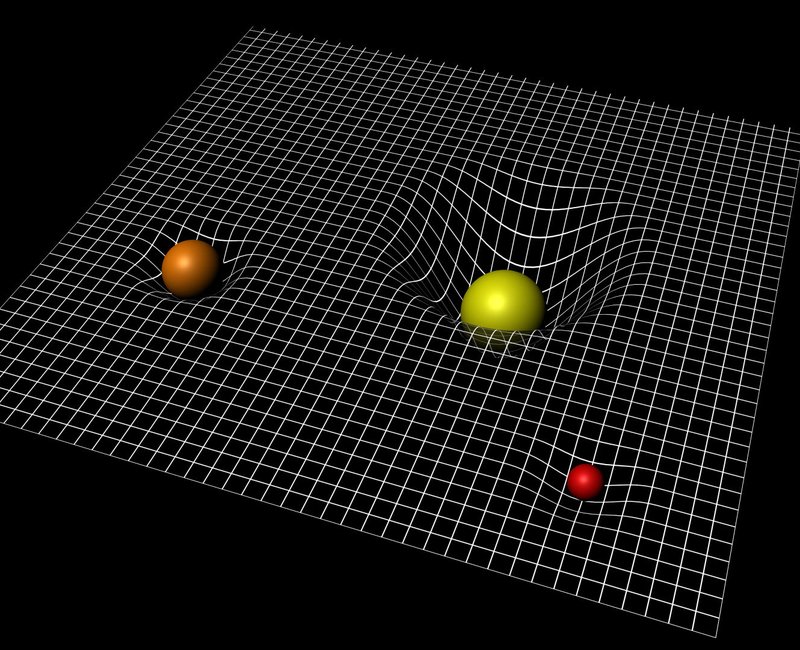
Space and time are dynamic
In this post we concretely analyze how spatial distance and time change between two moving entities
Stand up and head towards an object, such as the wall of your room. Since you are moving towards the wall the distance over time is reduced (obviously, since you are approaching the wall), but -much less obviously- the space between you and the object is compressed. If we indicate with s the distance between you and the wall (also known as proper distance), the distance S between you and the wall in motion is expressed by the simple formula (length contraction):
with v instantaneous speed compared to light speed (about 300,000 km per second in empty space). The speed v is a number without measurement unit (dimensionless - expresses the relationship between distance travelled by you and that of light considering the same time interval).
Instantaneous speed is measured in a very short (matematically infinitesimal) time interval. To give you a concrete example, this is the velocity indicated by the odometer in your car.
Please note that the difference in space is relative, i.e. does not depend on the measurement unit of the space interval. The higher the relative speed, the shorter the distance between you and the wall. As the speed between you and the wall approaches that of light, the very notion of space between you and the wall tends to vanish.
For speeds with which we deal every day, the phenomenon is exceptionally small, undoubtedly negligible. For example, a reasonable speed (brisk walking) could be 3 meters each second, which corresponds to
Therefore (since v is much less than one we can approximate the function with the first term of the Taylor series):
We are talking about a contracted distance of half a part in ten million billion, decidedly impossible to perceive and extremely difficult to measure. However, the phenomenon exists and becomes very significant for speeds approaching that of light (v close to one).
What are the implications for time measurement?
Imagine a scenario in which you are on board of a train, traveling from one station to another at constant speed v. Let S and T be your measurements of space and time, respectively, and s and t space and time measurements performed by someone at rest with respect to stations and railway (e.g., stationmaster). The speed measured by you on the train (S/T) must be equal to that measured by the stationmaster (s/t), i.e., it must be:
This principle (of reciprocity) derives from the assumption that the properties of space and time (unified in the construct of spacetime) are the same, independently from our location (homogeneity) and spatial direction of motion (isotropy).
By combining this simple relationship with the lenght contraction formula, we immediately obtain:
This is the relationship between the time interval T measured by you on the train (known as proper time between the two events: (1) train in one station (2) train in the other station) and the (proper) spatial interval s separating the two stations.
A concrete calculation
Let's suppose the train travels at the incredible speed v=0.866 (86.6% of the speed of light), corresponding to about 935 million km per hour. At this speed we have S = s/2, i.e. spatial distance (for you) is halved. Assuming that the distance between the stations is s = 150 million km (i.e. 500 seconds at the speed of light) -approximately the average distance from us and our Sun- you will reach the destination in:
seconds, that is, 4 minutes and 48 seconds. This is the so-called proper time between the two events, because such events occur in the same spatial position for you (and any passenger of the train). On the other hand, the time between the same events measured by the stationmaster, would be doubled:
576 seconds, i.e., 9 minutes and 36 seconds. Therefore, a spatial contraction for those who measure the proper time between the two events (like you and all train passengers), corresponds to a time dilation for those who measure the proper spatial distance and observe the events in different positions (like the stationmaster).
Doesn't that sound absurd?
It is for our intuition, which is based on the daily experience, in which all objects move at speeds ridiculously lower than light speed (non-relativistic setting). However, this is a fact of nature, verified in countless ways and with high accuracy by means of technological tools (impossible to reach purely with our senses). If it was not the case, for example, modern particle accelerators could never work (Proving special relativity: episode 2. Fermilab), or we could not explain the number of muons which reach us on the ground as a result of interactions between high-energy particles coming from space (called "cosmic rays" for historical reasons, C. R. Nave 2024) with the Earth's atmosphere.
The case of muons is particularly instructive. Muons are (today considered elementary) particles like electrons with mass 200 times higher (i.e. 200 times heavier). This high mass causes them to decay (i.e. "transform" into other lighter particles) in a very short time, in the order of 2 millionths of a seconds. Since muons produced in the earth atmosphere travel towards the ground at about 98% of light speed (v=0.98), for them the distance to the ground is about 5 times shorter, and those who observe from the ground (us) can explain the number of detected muons only considering a decay time 5 times longer (Movinka Bowie, Tom Hutchinson, Shivani Kanabar, and Shivakaran Sivanathan 2024).
Next article
In the next article we examine a key (amazing) aspect of nature which is somewhat "hidden" in the formula of length contraction and which could allow us to easily perform interstellar travels.
Find more blog posts with similar tags
